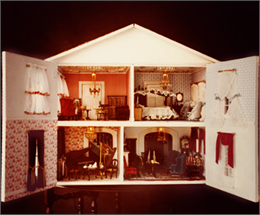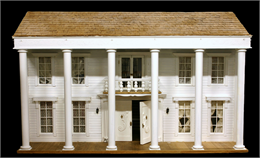Southern Colonial Dollhouse
Wisconsin Historical Museum Object – Feature Story
Southern Colonial dollhouse handmade and furnished by Ann Little of Columbus, Wisconsin, 1976-1977.
(Museum object #2007.191.1)
A dream house in miniature. That is how the maker of this intricate masterpiece, Ann Little, referred to her nine room Southern Colonial style dollhouse. Not only is the sheer size of the wooden house impressive, it is even more fascinating when the outer walls are opened revealing a highly detailed interior, finished to exacting scale.

Dollhouse Interior, 1976-1977
Made by Ann Little with help from Ron Balfanz, this dollhouse is impressive in both its large size and incredible interior detail. Source: Image courtesy of Marlee Jones from her 1977 dollhouse album
Each of the home's rooms depicts a different time period and interior design from 17th, 18th, and 19th century styles. This is especially fitting given that Little was a retired professional interior designer. She designed and planned the house and had the basic construction done by Ronald Balfanz in June 1977. Little completed the finish work, decorating, and furnishings later that year just before she fell seriously ill; she passed away shortly thereafter. During her career, Little was the buyer and designer for a Milwaukee furniture store. She then began her own practice and designed for clients in Wisconsin.
This massive dollhouse sits on a rotating base, and its sides and back open for easy viewing. The roof opens as well revealing the extensive wiring which brings electricity to the numerous light fixtures throughout. Every component is built to a one inch to one foot scale. Including the porches, the exterior measures 48 inches wide and 40 inches deep. The ceilings measure 10 inches high while the foyer extends to 20 inches in height.

Dollhouse Queen Anne Dining Room, 1976-1977
Mrs. Little's favorite room, the Queen Anne dining room, seen shortly after the house's completion. The room exemplifies intricate detail and features. Some of the miniature components were purchased at Marshall Field's in Chicago. Source: Image courtesy of Marlee Jones from her 1977 dollhouse album
Little's daughter, Marlee Jones, photographed the home extensively shortly after its completion and created an album to show her mother while Little was in the hospital. The dollhouse became a treasured family heirloom and was displayed in the homes of Little's daughters in Rio and Presque Isle, Wisconsin, as well as in South Carolina. It then resided in the home of Little's granddaughter in Cottage Grove, Wisconsin, before coming to the Wisconsin Historical Society.
The design styles range from a quaint Shaker kitchen to the elaborate Queen Anne dining room depicting a 1725 setting. Little carefully crafted the room's chandeliers from glass beads and delicate chains. The paintings on the walls are actual miniature paintings done by one of Little's art students. The Queen Anne style is also present in the foyer with its long staircase and intricately carved railing and posts. Other notable details include the real feather tick and bear rug made by Little and a purchased grandfather clock whose German-made works once kept time. Even the smallest details were not overlooked as tiny wax candles sit in handmade candlesticks.
Little's dollhouse is a fine example of miniature making; a hobby and pastime more suited to adults than children. Building one's own dollhouse requires hours of painstaking research and tremendous attention to detail and scale during fabrication. For pieces that can not be made, high quality manufactured pieces are commercially available, such as the pewter furniture in Little's house. These pieces can be somewhat expensive. In the end, the finished product is more a labor of love than plaything.
[Source: Spicer, Marcy. "For County Humane Society Columbus woman plans open miniature house," Portage Daily Register, 1977.]
JEK
Posted on November 20, 2008


